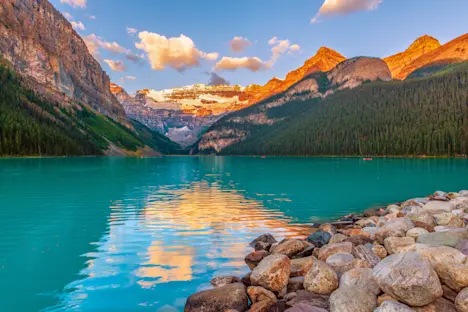
Moody Glacier Bay National Park in Southeast Alaska has snowcapped mountains, deep fjords and tidewater glaciers. What stays with me most, though, is its quiet nature. ©Candice Gaukel Andrews
The quietest place you may ever experience is next to a little pond off the Forest Trail in Glacier Bay National Park in Alaska. Hiking there just a couple of weeks ago, I found myself feeling a little unsettled without quite knowing why. I stopped moving for a moment and realized that it was the complete lack of sound that startled me. No wind rustling leaves; no birdsong; no humming of insects; no airplanes overhead or ship clangor. It was the first time in my life that I may actually have heard “The Sound of Silence,” as Simon & Garfunkel so poetically put it in their 1964 song. I didn’t want to leave.
Because our day-to-day world is filled with ambient noise, we’ve forgotten what complete silence is. Although we often don’t realize it, noise pollution is a fact of our lives and has become a major health problem in the 21st century.
Noise can be noxious
According to the World Health Organization, noise pollution is responsible for at least seven categories of adverse health effects in humans:
1. Hearing impairment. Noise-induced hearing loss (NIHL) can be caused by a one-time exposure to an intense impulse sound, such as an explosion, or by a continuous exposure to loud sounds over an extended period of time.

By the side of a little pond off the park’s Forest Trail, you’ll find a spot of complete silence. ©Candice Gaukel Andrews
Sound is measured in units called decibels. Noises of less than 75 decibels, even after long exposure, are unlikely to cause hearing loss. However, long or repeated exposure to sounds at or above 85 decibels can result in a hearing decline. The louder the sound, the shorter the amount of time it takes for NIHL to happen.
In cities and neighborhoods, lawn mowers, leaf blowers and woodworking tools can cause NIHL.
2. Disturbed sleep. Environmental noise is one of the major causes of disturbed sleep. Chronic sleep disruption may result in mood swings and a decreased ability to perform tasks.

The southern part of Glacier Bay National Park is a temperate rain forest. ©John T. Andrews
3. Cardiovascular disease. Acute exposure to noise activates nervous and hormonal responses, leading to temporary increases in blood pressure, heart rate and vasoconstriction.
4. Acceleration and intensification of latent mental disorders. Noise pollution is not believed to be a cause of mental illness, but it is assumed to accelerate and intensify anxiety, argumentativeness, depression, emotional instability, hysteria, nervousness, neurosis, psychosis and stress.
5. An increase in aggressive behavior and a decrease in behavior helpful to others. Violent behavior and social conflicts often arise out of disputes over noise; in many cases these altercations end in injury or death.

Glacier Bay National Park’s glaciers help wildlife thrive. Harbor seals give birth on icebergs. Some seabirds nest near glaciers. Cold, silty, glacier meltwater is habitat for small fish which feed larger fish and other animals. ©Doug Davey, flickr
6. Cognitive task performance impairment. Noise pollution impairs task performance at school and at work, increases errors and decreases motivation.
7. Annoyance. Annoyance is defined as a feeling of displeasure associated with any agent or condition believed by an individual to adversely affect him or her. The term, however, doesn’t cover the wide range of negative reactions associated with noise pollution, including agitation, anger, disappointment, dissatisfaction, distraction, exhaustion, helplessness and withdrawal. Lack of perceived control over the noise intensifies the effects.
Quiet can be contagious
It’s no wonder that once we hear true quiet, we begin to crave the silent spots. It seems that other animals are drawn to them, too. The Great Bear Rain Forest of British Columbia, Canada, is currently having an ecological resurgence. Herring, sea otters and humpback whales are returning to Caamano Sound near Hartley Bay. Last year, whale biologists Hermann Meuter and Janie Wray reported that they have seen increases in whale numbers and types in the 11 years that they have had a research station on Gil Island.

For me, Alaska’s Glacier Bay National Park will always be my refuge from noise.
Humpback whales were thought to have been extirpated from the B.C. coast by 1966, the year commercial whaling was banned. But a decade ago, Meuter and Wray counted a few dozen humpback whales in the area. Now, they tally more than 300 individuals. Some, such as Ian McAllister of Pacific Wild, speculate that the revival is due to the lack of noise pollution in the area; that here is one of the last quiet refuges where acoustically sensitive whales can still communicate, forage, feed and raise their calves without having to “shout” over the din of tanker traffic.
It’s clear that we and the “others” with whom we share the planet need these refuges from noise. I’ll never forget that pond in Glacier Bay National Park. But it won’t be because it had a grand vista or stupendous view of a mountain. In fact, by looks, it was rather unremarkable. The “image” I keep of it in my heart isn’t one of the seeing variety. In the words of Simon & Garfunkel:
“And the vision that was planted in my brain
Still remains within the sound of silence.”
Here’s to finding your true places and natural habitats,
Candy






























